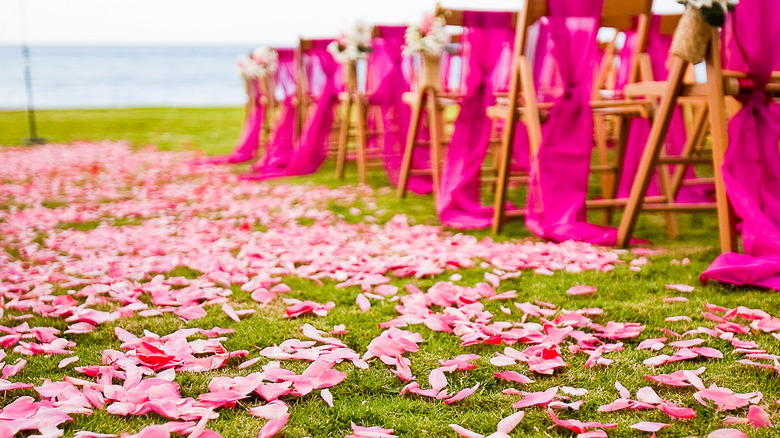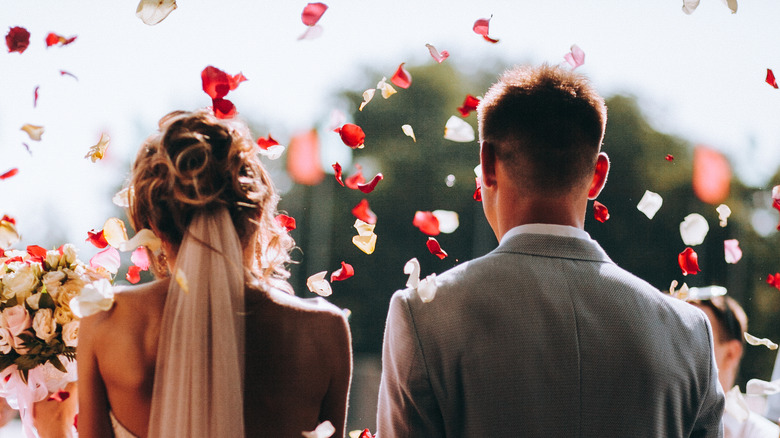Where Did The Idea Of A Flower Girl At A Wedding Come From?
Despite the staunchness of marriage, the institution is still subject to changing trends. Rituals fade in and out of popularity and marriages have changed over the years as a result. Weddings have changed, too — as have wedding parties — and flower girls are no exception. Over the years, the role of the flower girl has evolved.
Anna Post, the great-great-granddaughter of Emily Post — a socialite who became an etiquette columnist and founder of the Emily Post Institute Inc. — described the modern-day role of a flower girl in an article for Inside Weddings (via The Emily Post Institute). Post explained that the flower girl follows the ring bearer and is the last member of the wedding party to walk down the aisle, laying out a path of flower petals for the incoming bride.
This is the flower girl tradition popular today, but the roots of the role are a little bit different and not very well-known.
Ancient roots of wedding flower girls
It's likely that the early flower girls weren't flower girls at all but rather herb and grain children.
Many sources trace the origins of the flower girl to Ancient Rome. While modern flower girls are honored guests at the wedding, according to an article published in the Family Relations journal, their ancient counterparts "were included to encourage fertility." In order to do this, event planner Roxanne Bellamy told Brides.com that young girls in ancient Greek and Roman wedding parties were given grains and herbs to sprinkle along the bride's path. As Europe moved into the Medieval Period, garlic and dill subbed the sheaths of wheat as the girls' offerings. They were held by the children to ward off evil, as wedding expert Eleni N. Gage wrote in "Lucky In Love: Traditions, Customs, and Rituals to Personalize Your Wedding."
As years have gone by, what young girls symbolized and how important they were to a wedding procession varied. In the Elizabethan era, Bellamy said, predecessors to modern flower girls represented the first stage of a bride's life — innocence — and were part of a succession that included the bride's maids, the bride, and the mother of the bride, each representing a different stage of a woman's life. Per Gage, instead of toting plants, they "carried a silver chalice known as a 'bride's cup.'"
Victorian origins of flower girls in weddings
According to Merriam Webster, the first known use of the phrase "flower girl" to describe the child that prances down the wedding aisle sprinkling flower petals was in 1902. Before then, a flower girl most likely referred to a young woman who sold flowers on the street or at a market. These flower girls were often the subjects of paintings, such as Charles Cromwell Ingham's "The Flower Girl" from 1846, which is now at the Metropolitan Museum of Art in New York.
The term has also been used to describe girls who scattered flowers over the path of a different kind of procession: Queen Victoria's coronation in 1838 included a procession of young girls throwing flower petals onto her path that The New York Times referred to as "flower girls" in a 1928 obituary for one of the royal's flower girls. This is the same Queen Victoria whose trendsetting wedding marked the beginning of the white wedding dress tradition in the West and established a new standard for wedding celebrations on the whole (via Vanity Fair). While we can't credit Queen Victoria for the origin of flower girls at weddings, they are still a fixture in many a ceremony.
According to Mental Floss, today's flower girls are tasked with giving the bride her trail of flowers, charting a path towards a happy life with her soon-to-be spouse.


